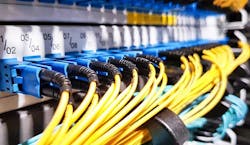Ecosystems at The Edge: Interconnection Enables New Services
Last week in our special report series, we looked at multi-tiered architecture and distributed intelligence, as well as the global potential of ecosystems and the edge. This week, we’re looking at how interconnection is key for edge data centers. We’ll also explore some of the factors that should be considered when selecting a colocation provider.
Get the full report.
Interconnection is Key
Interconnection will be a critical consideration for enterprises building out edge data centers. It enables data exchange between two or more entities or partners at the fastest possible speed by combining high-performance networks with physical proximity. Customers avoid the unpredictability and cost of the public Internet.
Interconnection enables business partners to rapidly connect to speed new services to market and to improve performance, availability and functionality. Customers using multiple cloud providers can enjoy access speeds equivalent to dedicated on-ramps along with the flexibility to switch sessions easily between cloud providers and transfer data with lower egress charges. It’s not surprising that worldwide interconnection bandwidth capacity more than quadrupled between 2017 and 2020 to 5,000 terabits per second.
Interconnection today is principally the domain of large companies like financial services institutions, manufacturers, cloud computing providers and telecommunications firms, but the growth of edge infrastructure will draw in smaller firms and local use cases. This is a major business opportunity for edge data center operators.
The Colocation Option
Edge strategies should start small and grow incrementally using infrastructure that can scale to full-blown data center functionality over time. Because edge applications are, by their nature, latency-sensitive, organizations must be prepared to expand capacity without time-consuming and expensive acquisition of new real estate and equipment.
Most edge computing architectures will make use of colocation partners like Iron Mountain that already have facilities in place, the ability to turn current facilities into full or partial data centers and knowledge of local markets. Once the domain of primarily large enterprises, colocation data centers have evolved to provide a variety of customizable services that support a wide range of businesses. These include on-site assembly and testing, inspection and maintenance, inventory analysis and 24-hour services.
Many colocation providers offer redundant HVAC systems and multiple cooling options such as centrifugal chillers, adiabatic cooling solutions and water loop pumps.
Colocation providers typically provide reliable power with redundancy and battery backup or uninterruptible power supplies. They maintain physical security controls that include guards, full-time surveillance and multiple forms of authorization. Many also offer redundant HVAC systems and multiple cooling options such as centrifugal chillers, adiabatic cooling solutions and water loop pumps.
Perhaps most importantly, colocation providers know the territory. “The best space, power and connectivity in every geography everywhere in the world is owned and operated by a data center company in that place,” wrote Jonathan Seelig, CEO of the globally distributed cloud platform Ridge in The Linux Foundation’s State of the Edge report.
Once the domain of primarily large enterprises, colocation data centers have evolved to provide a variety of customizable services that support a wide range of businesses.
Not all colocation partners are alike, however. The factors that should influence a business’ choice of edge partners include:
Interconnection capacity – This includes the amount of bandwidth available for interconnection services, the types of available interconnection (peering, cross-connect, internet-site connectivity, blended IP) and service-level agreements.
Room to expand – In addition to existing colocation facilities, operators should have facilities or real estate that can be transformed quickly into data centers on a global scale in second- or third-tier locations to serve new edge customers.
Partner ecosystem – Look for co-location providers that have existing partnerships with a wide range of carriers, cloud providers, CDNs and managed service providers to offer their customers the widest variety of options.
Data Center Frontier’s Editor in Chief Rich Miller and executives from Iron Mountain discuss Ecosystems and the Edge. Watch on demand today!
Workload capacity – The service should have the physical space available to expand without compromising on security, environmental controls or service levels.
Bandwidth – An edge configuration is likely to involve a connection to an internet service provider. Ensure that ample bandwidth and multiple redundant connections are available. Bandwidth should be
over-provisioned so that there is no risk of running up against peak usage thresholds.
Backup/business continuity – Redundant power sources, bandwidth and HVAC systems are factors here. The provider should have plenty of UPS capacity and be willing to provide service-level guarantees.
Ability to support devices in the field – “Remote hands” support in the data center should also extend to the devices you plan to deploy in the field. Make sure the provider has the necessary skills and equipment to fulfill your needs on a schedule that works for you.
Security – Because co-location facilities are shared by their nature, equipment must be secure. Look for features such as video surveillance, keycard or biometrics access, mantraps and security personnel to regulate site access and locked cages for your owned equipment.
Administration & monitoring – You should have full visibility into the status of your equipment at any time.
Download the full report, “Ecosystems & the Edge: Where the Data Center Becomes a Transactional Marketplace” courtesy of Iron Mountain to learn more about how the edge can help small data centers transform into full-fledged service providers and fuel digital transformation. In our final article, we’ll compare the cloud versus colocation. Catch up on previous articles here and here.


